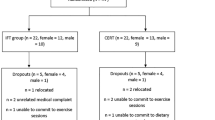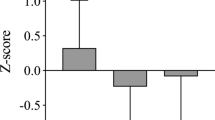Abstract
Purpose
The follow-up of anthropometric percentiles such as triceps and mid-thigh skinfold thickness (TSF, MTSF), mid-upper arm and mid-thigh circumferences (MUAC, MTC), and arm and mid-thigh muscle areas (AMA, MTMA) after a resistance training might allow for detecting nutritional progress of fat and muscular tissue during the treatment of anorexia nervosa restricting (AN-R) type patients.
Methods
A total of 44 AN-R patients were randomized for control (CG 13.0 ± 0.6 years) and intervention (IG 12.7 ± 0.7 years) groups after hospitalization. The intervention group underwent a resistance training program of 8 weeks following the guidelines for healthy adolescents (3 days/week; 70 % of 6 RM). All measurements were obtained prior to starting the program (PRE) and after 8 weeks of training (POST) in both groups. TSF, MTSF, MUAC, and MTC were measured, and AMA and MTMA were calculated. Data were matched with percentile tables for general population. Changes were assessed using statistical tests for categorical data.
Results
The distribution of percentile categories within the groups did not differ statistically after 8 weeks (p > 0.05). After training, 73 % of the patients were at the same percentile interval of MUAC, 18 % higher and 9 % lower, while 30 % of CG was at lower percentile categories. Further, 54 % of the IG patients remained at the same percentile interval of MTC after training, and 36 % higher, while 20 % were at lower categories in the CG. The AMA increased (32 %) after training or remained at the same interval (59 %) in the IG, while the IG showed greater frequency of percentile decreases (45 %).
Conclusions
Anthropometric measurements could be useful for assessing muscle status in AN-R patients during the treatment process. However, exact standard deviation scores should be used instead of percentile categories to increase the sensitivity to changes in TSF, MTSF, MUAC, MTC or AMA.


Similar content being viewed by others
References
Konstantynowicz J, Abramowicz P, Jamiolkowski J, Kadziela-Olech H, Bialokoz-Kalinowska I, Kierus-Jankowska K, Piotrowska-Jastrzebska J, Kaczmarski M (2011) Thigh circumference as a useful predictor of body fat in adolescent girls with anorexia nervosa. Ann Nutr Metab 58:181–187. doi:10.1159/000329437
Haas VK, Kohn MR, Clarke SD, Allen JR, Madden S, Muller MJ, Gaskin KJ (2009) Body composition changes in female adolescents with anorexia nervosa. Am J Clin Nutr 89:1005–1010. doi:10.3945/ajcn.2008.26958
Probst M, Goris M, Vandereycken W, Van Coppenolle H (1996) Body composition in female anorexia nervosa patients. Br J Nutr 76:639–647. pii: S0007114596001754
de Onis M, Onyango AW, Borghi E, Siyam A, Nishida C, Siekmann J (2007) Development of a WHO growth reference for school-aged children and adolescents. Bull World Health Organ 85:660–667
Cole T, Lobstein T (2012) Extended international (IOTF) body mass index cut-offs for thinness, overweight and obesity. Pediatric obesity 7:284–294. doi:10.1111/j.2047-6310.2012.00064.x
Ogden CL, Kuczmarski RJ, Flegal KM, Mei Z, Guo S, Wei R, Grummer-Strawn LM, Curtin LR, Roche AF, Johnson CL (2002) Centers for Disease Control and Prevention 2000 growth charts for the United States: improvements to the 1977 National Center for Health Statistics version. Pediatrics 109:45–60
Nova E, Varela P, Lopez-Vidriero I, Toro O, Ceñal M, Casas J, Marcos A (2001) A one-year follow-up study in anorexia nervosa. Dietary pattern and anthropometrical evolution. Eur J Clin Nutr 55:547–554
Vandereycken W (1983) Outpatient management of anorexia nervosa. Pediatrician 12:118–125
Calogero RM, Pedrotly KN (2004) The practice and process of healthy exercise: an investigation of the treatment of exercise abuse in women with eating disorders. Eat Disord 12:273–291
Bratland-Sanda S, Sundgot-Borgen J, Ro O, Rosenvinge JH, Hoffart A, Martinsen EW (2010) Physical activity and exercise dependence during inpatient treatment of longstanding eating disorders: an exploratory study of excessive and non-excessive exercisers. Int J Eat Disord 43:266–273. doi:10.1002/eat.20769
Tokumura M, Yoshiba S, Tanaka T, Nanri S, Watanabe H (2003) Prescribed exercise training improves exercise capacity of convalescent children and adolescents with anorexia nervosa. Eur J Pediatr 162:430–431. doi:10.1007/s00431-003-1203-1
Chantler I, Szabo CP, Green K (2006) Muscular strength changes in hospitalized anorexic patients after an eight week resistance training program. Int J Sports Med 27:660–665. doi:10.1055/s-2005-865812
Carei TR, Fyfe-Johnson AL, Breuner CC, Brown MA (2010) Randomized controlled clinical trial of yoga in the treatment of eating disorders. J Adolesc Health 46:346–351. doi:10.1016/j.jadohealth.2009.08.007
Thien V, Thomas A, Markin D, Birmingham CL (2000) Pilot study of a graded exercise program for the treatment of anorexia nervosa. Int J Eat Disord 28:101–106
del Valle MF, Perez M, Santana-Sosa E, Fiuza-Luces C, Bustamante-Ara N, Gallardo C, Villasenor A, Graell M, Morande G, Romo GR, Lopez-Mojares LM, Ruiz JR, Lucia A (2010) Does resistance training improve the functional capacity and well being of very young anorexic patients? A randomized controlled trial. J Adolesc Health 46:352–358. doi:10.1016/j.jadohealth.2009.09.001
Touyz SW, Lennerts W, Arthur B, Beumont PJ (1993) Anaerobic exercise as an adjunct to refeeding patients with anorexia nervosa: does it compromise weight gain? Eur Eat Disord Rev 1:177–182
Alberti M, Galvani C, Capelli C, Lanza M, El Ghoch M, Calugi S, Dalle Grave R (2013) Physical fitness before and after weight restoration in anorexia nervosa. J Sports Med Phys Fit 53:396–402
Melchiorri G, Rainoldi A (2008) Mechanical and myoelectric manifestations of fatigue in subjects with anorexia nervosa. J Electromyogr Kinesiol 18:291–297
Kerruish KP, O’Connor J, Humphries IR, Kohn MR, Clarke SD, Briody JN, Thomson EJ, Wright KA, Gaskin KJ, Baur LA (2002) Body composition in adolescents with anorexia nervosa. Am J Clin Nutr 75:31–37
Martin AC, Pascoe EM, Forbes DA (2009) Monitoring nutritional status accurately and reliably in adolescents with anorexia nervosa. J Paediatr Child Health 45:53–57. doi:10.1111/j.1440-1754.2008.01427.x
Mattar L, Godart N, Melchior JC, Pichard C (2011) Anorexia nervosa and nutritional assessment: contribution of body composition measurements. Nutr Res Rev 24:39–45. doi:10.1017/S0954422410000284
APA: American Psychiatric Association (2000) Diagnostic and statistical manual of mental disorders: DSM-IV-TR. American Psychiatric Publishing, Inc., Washington, DC
Davis C, Katzman DK, Kaptein S, Kirsh C, Brewer H (1997) The prevalence of high-level exercise in the eating disorders: etiological implications. Compr Psychiatry 38:321–326
Beumont PJ, Arthur B, Russell JD, Touyz SW (1994) Excessive physical activity in dieting disorder patients: proposals for a supervised exercise program. Int J Eat Disord 15:21–36
Marfell-Jones MJ, Stewart AD, de Ridder JH (2012) International Standards for anthropometric assessment. International Society for the Advancement of Kinanthropometry (ISAK), Lower Hutt, New Zealand
Heymsfield SB, McManus C, Smith J, Stevens V, Nixon DW (1982) Anthropometric measurement of muscle mass: revised equations for calculating bone-free arm muscle area. Am J Clin Nutr 36:680–690
Faigenbaum AD, Kraemer WJ, Blimkie CJ, Jeffreys I, Micheli LJ, Nitka M, Rowland TW (2009) Youth resistance training: updated position statement paper from the national strength and conditioning association. J Strength Cond Res 23:S60–S79. doi:10.1519/JSC.0b013e31819df407
Cohen J (1988) Statistical power analysis for the behavioral sciences. Hillsdale, NJ, Erlbaum
Scalfi L, Polito A, Bianchi L, Marra M, Caldara A, Nicolai E, Contaldo F (2002) Body composition changes in patients with anorexia nervosa after complete weight recovery. Eur J Clin Nutr 56:15–20
Kawai K, Yamashita S, Yamanaka T, Gondo M, Morita C, Nozaki T, Takakura S, Hata T, Yamada Y, Matsubayashi S (2011) The longitudinal BMI pattern and body composition of patients with anorexia nervosa who require urgent hospitalization: a case control study. Biopsychosoc Med 5:14. doi:10.1186/1751-0759-5-14
Acknowledgments
The authors thank the participants and the personnel of the Unit of Psychiatry and Psychology at the hospital for their cooperation. We thank also Texas Tech Writing Center for the contribution in editing this manuscript.
Conflict of interest
The authors have no conflict of interests to disclosure.
Author information
Authors and Affiliations
Corresponding author
Rights and permissions
About this article
Cite this article
Fernandez-del-Valle, M., Larumbe-Zabala, E., Graell-Berna, M. et al. Anthropometric changes in adolescents with anorexia nervosa in response to resistance training. Eat Weight Disord 20, 311–317 (2015). https://doi.org/10.1007/s40519-015-0181-4
Received:
Accepted:
Published:
Issue Date:
DOI: https://doi.org/10.1007/s40519-015-0181-4




